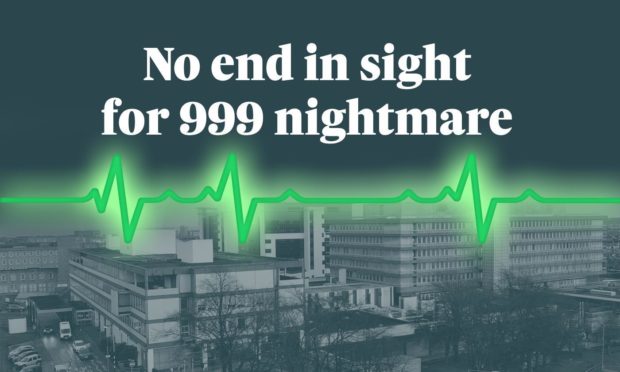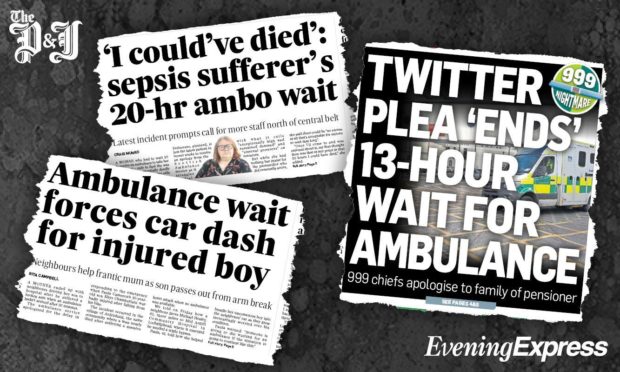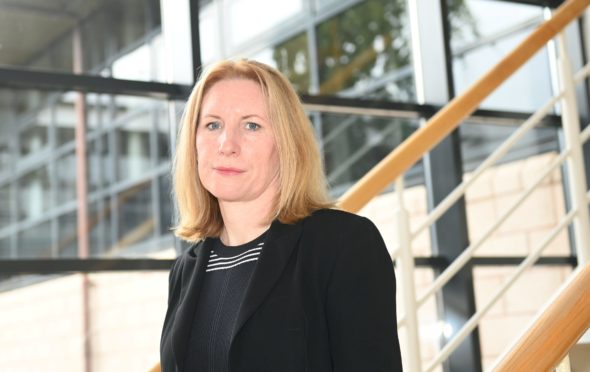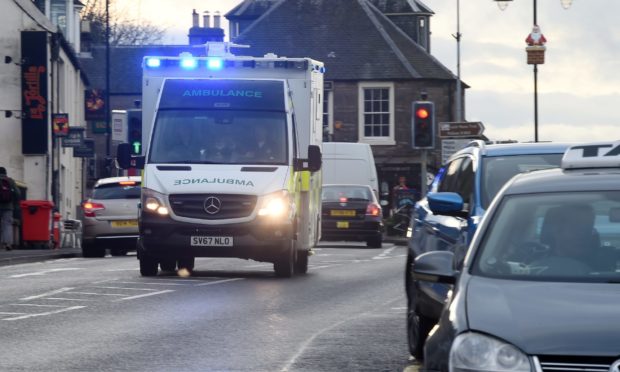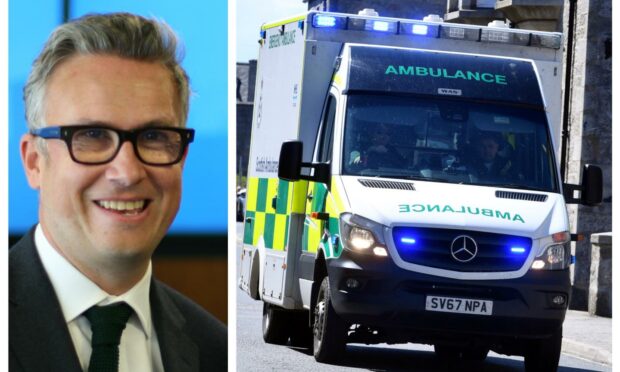Health chiefs have admitted there is no end in sight to horror ambulance delays which have left patients waiting as long as 20 hours for treatment.
Over recent weeks, the crisis facing the Scottish Ambulance Service has been laid bare with people across the north and north-east left in agony as they await help.
The problem has been caused by a post-lockdown spike in admissions to A&E wards, which are still operating at reduced capacity due to Covid.
It means that, in many cases, paramedics are being forced to wait hours before being able to take patients through hospital doors.
NHS Grampian told us that a perfect storm of circumstances meant staff were “under more pressure than at any other time throughout the pandemic”.
Bosses also appealed for people to do their bit to help, by only calling 999 when absolutely necessary.
‘This is not what anyone wants’
NHS Grampian, NHS Highland and the Scottish Ambulance Service together issued us with an exclusive statement.
They warned there is little hope for improvement in the immediate future without the public’s assistance.
Chief executive for NHS Grampian, Professor Caroline Hiscox, said: “At the moment we can’t increase hospital capacity further or immediately improve on staff shortages.
“However, if the public continues to work with us we can reduce the number of people attending hospital when another treatment option would be more appropriate.”
She added: “Ambulances having to wait at the front door of our hospitals is not what anyone would want and we apologise to anyone who has been impacted by this.
“However, across Scotland, the NHS is experiencing significant sustained pressure which has been immeasurably exacerbated by the Covid-19 pandemic.
“And we – NHS Grampian, NHS Highland and the Scottish Ambulance Service – are not immune to that impact.”
Domino effect to blame
Prof Hiscox said that tightened capacity in hospitals had combined with staffing issues to push resources to breaking point.
“Although society is reopening, health and care services are under more pressure than at any other time throughout the pandemic,” she said.
“We do not work in isolation: if one service is impacted, it affects us all.
“Using our emergency department at Aberdeen Royal Infirmary as an example; staff there are experiencing periods of exceptionally high demand.
“This can result in abnormally intense surges of patients arriving at hospital, at the same time, and can unfortunately lead to us being unable to admit more patients to the department.
“This is when ambulance stacking occurs.
“That pressure isn’t just affecting the emergency department and ambulance service – it is felt right across our system including social and primary care.”
Ambulance boss on nightmare scenario
Efforts are made to ensure patients in life-threatening situations, such as heart attack or stroke victims, are “admitted rapidly for life-saving treatment as an absolute priority”.
But Pauline Howie, chief executive of the Scottish Ambulance Service, explained why others might feel left in the lurch.
She said: “Lengthy hospital turnaround times and staff abstractions are currently putting considerable pressure on how quickly we can reach patients.
“The easing of Covid restrictions has also increased demand and the combination of these factors is impacting on our service.
“We are sorry that some non-life-threatening patients are experiencing delays and we are working in partnership with health boards to mitigate these pressures as much as possible.”
Rural nature of Highlands poses challenges
NHS Highland chief executive, Pam Dudek, said tourists finding themselves in need of hospital treatment was making the situation even worse in popular visitor areas.
She said: “On top of the surges in patients and reduction in capacity, the patients who are coming in requiring emergency care are more unwell than we are used to seeing at this time of year.
“More are requiring longer to recover which also affects their length of stay in hospital.
“We are also seeing increased demand, with returning levels of tourism, from the number of out of area patients attending accident and emergency.
“The impact of staff having to isolate has led to gaps and pressures in our service.
“These absences add to pressures as a result, and we are already coping with usual staff sickness and those on leave.”
Praise for hard-pressed healthcare heroes
Ms Dudek said each body wished to thank their “fantastic and dedicated staff” who have been doing “a tremendous job under immeasurable pressure for nearly 18 months”.
She added: “They truly have been herculean. Without them many, many more people would have lost their lives during this pandemic.”
Prof Hiscox also thanked the public for their support, but pleaded with people to call 111 or contact their GP for advice in situations which are not life-threatening.
She added: “In doing this you can help us to maximise the capacity we have and ensure those who are most acutely ill can get a bed. No one wants patients delayed in receiving vital care.”
Catalogue of complaints
We have recently spoken to patients left in despair as they had to wait far longer than anticipated for blue light crews to arrive at their door.
Ann-Marie Smart, who lives near Stonehaven, was furious when paramedics arrived 20 hours after she called for help. She was later diagnosed with sepsis at Aberdeen Royal Infirmary.
Businessman Iain Anderson claimed a 13-hour wait for an ambulance to take his grieving mother to hospital in Aberdeen only ended because he pleaded for help on Twitter.
But it was not until shortly before 7am the following morning that paramedics finally arrived.
He later needed a triple bypass operation to save his life.
Dire ambulance delays nationwide
Meanwhile, it emerged yesterday that the number of seriously ill people left waiting more than 10 minutes for an ambulance has more than doubled since 2019.
In response to a written question from Scottish Labour deputy leader, Jackie Baillie, the Health Secretary, Humza Yousaf, released the alarming figures.
These are shocking statistics.
Failure to support ambulance services is playing fast and loose with the lives of Scots. https://t.co/mr7vPDrn7p
— Jackie Baillie (@jackiebmsp) August 12, 2021
They showed that 4,247 people waited between 10 and 29 minutes for an ambulance to attend when their case was deemed the most serious in the 2020-21 financial year.
That figure is up from 1,932 in 2018-19.
Ms Baillie said: “It’s clear that ambulance waiting times are on the rise and that lives are being risked as a result.”
